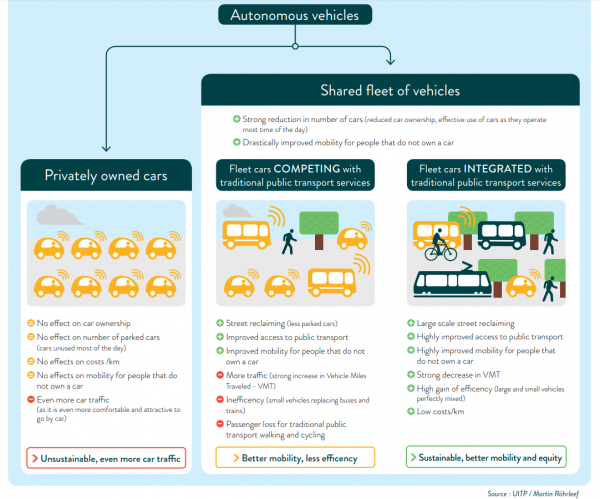This post is part of a mini-series on car sharing and mobility. Read the others here:

From Canada to Australia, the Netherlands to Singapore, countries are opening up the roads to self-driving cars, or autonomous vehicles (AVs). Since 2017, the world has seen a huge acceleration in policies encouraging their development. Several companies are now making strategic alliances to bring the next-generation technology to the market by 2024. This past July, BMW and Daimler announced a partnership to develop technologies for driver assistance systems, highly-automated driving on highways, and automated parking (all up to SAE Level 4). Likewise, Ford and Volkswagen have taken their existing partnership to the next level, with two new initiatives that will advance their respective AV and EV efforts. And Mazda, Suzuki, Subaru, Isuzu, and Daihatsu have all pledged to invest in Toyota’s autonomous driving joint venture with SoftBank.
Vehicle automation is regarded as the next big technological change in transportation. With it comes significant opportunities—and challenges—in transportation planning. One question that we work on here at LGI is: how can we use AVs to contribute to a sustainable future?
It is clear that a future based on individual ownership of AVs would not exploit their potential. Rather, one plausible scenario is that they could easily lead to an increase in total vehicle mileage, with no reduction in car ownership (and therefore no reduction in the related amount of traffic and space that cars take up, currently two major challenges for many cities). Indeed, such a scenario would most likely worsen the situation, as more vehicles would be on the roads with no occupants inside, going back and forth to pick up the individual owners.
One scenario that could bring about revolutionary changes in vehicle ownership, traffic congestion and parking spaces is if AVs are part of a shared network, complementing an efficient, high-capacity public transport system (see figure below). There are two main ways this could play out:
- Shared AVs offer services similar to that of the existing one-way car sharing programmes
- AVs are used as Robo-Taxis and on-demand shuttles, offering both door-to-door and last mile solutions that feed into public transport hubs

Opportunities of shared fleets integrated with traditional public transport systems (UITP, 2017)
Such a scenario would also provide greater public transport options to citizens, including those living in areas where it is currently difficult or impossible to provide such services. However, the path to achieving this scenario is not certain. For example, we do not yet know how AVs will be rolled out in our cities, and regulation will play a key role. Furthermore, a network of AVs would require them to communicate with each other – something that only about 8% of cars currently do. Plus, as many cars stay on the road for a decade or longer, this means that it will take some time before a network could actually be developed. This goes without saying that it also depends upon social acceptance of the emerging technology – to date, little is known about the factors that may sway public opinion to reject it.
Given current development trends, fully autonomous vehicles could be just a decade away. We have a unique opportunity to bring about a fundamental change in our cities, but for this happen, public authorities and public transport companies must take an active role NOW. An integrated approach that uses both co-design and participatory action research to incorporate citizen perspectives into transport planning and implementation will be essential. Let’s get rolling!

The views and opinions expressed in this blogpost are solely those of the original author(s) and/or contributor(s). These views and opinions do not necessarily represent those of LGI or the totality of its staff.




FOLLOW US